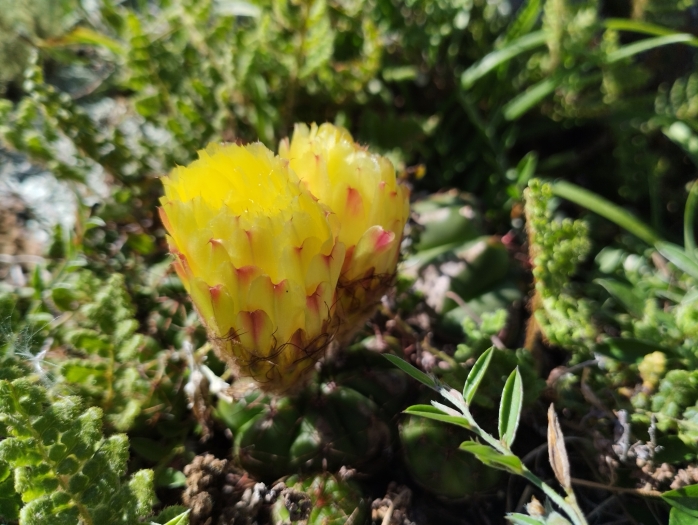Indian Head Cactus
(Parodia ottonis)
Indian Head Cactus (Parodia ottonis)
/
/

Agustina Medina
CC BY 4.0
Image By:
Agustina Medina
Recorded By:
Copyright:
CC BY 4.0
Copyright Notice:
Photo by: Agustina Medina | License Type: CC BY 4.0 | License URL: http://creativecommons.org/licenses/by/4.0/ | Rights Holder: Agustina Medina | Publisher: iNaturalist | Date Created: 2023-11-24T08:41:13-08:00 |

























Estimated Native Range
Summary
Parodia ottonis, commonly known as Indian head cactus, is a perennial herbaceous succulent native to the grasslands and rocky outcrops of Argentina, Brazil, Paraguay, and Uruguay. This cactus typically forms clusters of spherical to slightly elongated stems that can reach up to 6 inches (15 cm) in height and diameter. The stems are light to dark green or blue-green and feature prominent, rounded or sharp-edged ribs lined with areoles from which spines emerge. During the flowering season, which occurs in late spring to early summer, it produces vibrant yellow flowers at the crown of the stem, adding to its ornamental appeal.
Indian head cactus is appreciated for its low maintenance and drought tolerance, making it a popular choice for rock gardens, cactus collections, and as a potted plant for indoor and outdoor settings. It requires minimal water, thriving in well-drained soils and preferring full sun to partial shade conditions. While it is generally pest-free, overwatering can lead to root rot. It is not known to be invasive when grown outside its native range.CC BY-SA 4.0
Indian head cactus is appreciated for its low maintenance and drought tolerance, making it a popular choice for rock gardens, cactus collections, and as a potted plant for indoor and outdoor settings. It requires minimal water, thriving in well-drained soils and preferring full sun to partial shade conditions. While it is generally pest-free, overwatering can lead to root rot. It is not known to be invasive when grown outside its native range.CC BY-SA 4.0
Plant Description
- Plant Type: Succulent
- Height: 0.5-1.5 feet
- Width: 0.5-1 feet
- Growth Rate: Slow
- Flower Color: Yellow
- Flowering Season: Spring, Summer
- Leaf Retention: Evergreen
Growth Requirements
- Sun: Full Sun
- Water: Medium
- Drainage: Fast
Common Uses
Drought Tolerant, Low Maintenance, Potted Plant, Rock Garden, Showy Flowers
Natural Habitat
Grasslands and rocky outcrops
Other Names
Common Names: Golden Ball Cactus
Scientific Names: , Parodia ottonis, Cactus ottonis, Echinocactus amambayensis, Echinocactus araneolarius, Echinocactus araneolarius, Echinocactus arechavaletae, Echinocactus arechavaletai, Echinocactus ottonis, Echinocactus ottonis f. brasiliensis
GBIF Accepted Name: